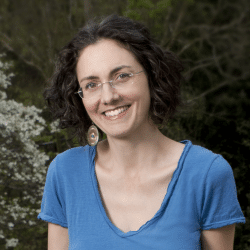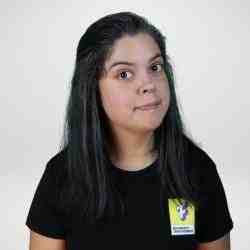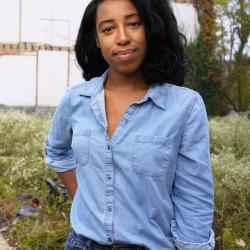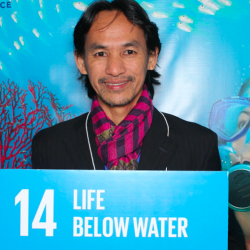Introduction
Tessy ensures that neighborhoods have the social infrastructure for participation and social cohesion of the community. With each application in a new neighborhood, Every One Every Day changes how we live in cities and how cities are designed for participation and not for isolation.
The New Idea
People live in cities in an isolated, cemented way, which is far from being at one with the environment. Neighborhoods were designed to increase consumption not collaboration and residents very rarely contribute to shaping their environments because there is no infrastructure for that. In order to change the way people live in and shape their urban neighborhoods, Tessy and her organization Participatory City, are building the Every One Every Day ecosystem, making every day neighborhood and community participation possible for all. The Every One Every Day approach is highly adaptive and focuses on developing a learning, knowledge, and capacity-building model through fostering deep working and learning partnerships. It is based on Tessy’s idea of Universal Basic Everything, saying that there are systems, tangible and intangible, that we need to survive and thrive. To survive, neighborhoods, cities, and countries rely on critical basic infrastructure and services — like hospitals, roads, and waste collection. To thrive, however, neighborhoods, cities, and countries also need robust social infrastructures, also known as ‘third places.’ People need the opportunity to create friendships and relationships, as well as collect knowledge to work together as forces for good in their neighborhoods. In order to do this, they require basic, accessible tools, resources, and spaces to collectively create not only the products but also the networks of cooperation that are the building blocks of a healthy, sustainable society – from a cup of coffee with neighbors to joining one session, to co-creating community projects and co-creating new livelihoods together.
Through the Every One Every Day model, Tessy invites residents and neighborhoods to co-create practical everyday projects that build on local assets and meets local needs, whilst encouraging social cohesion. In collaboration between residents, neighborhoods, organizations, and governments, Tessy is working with communities to create spaces, platforms, and relationships that bring people together in ways that benefit each other and the earth. Every One Every Day is inclusive and accessible at its core – all residents can access a project in their neighborhood within a maximum 15-minute walking radius. Additionally, projects are designed to be practical, easy, and ‘hands on,’ for people of all ages and abilities to work together on an equal footing in an enjoyable way. Projects have included knitting, pottery, and cooking, with the support of the Participatory City team making sure that all formal and organizational requirements to launch a project are met. In some cases, these projects have also led to community businesses being formed.
Every One Every Day was successfully piloted in Barking and Dagenham, East London, and was prototyped in Halifax (Kji'puktuk), Nova Scotia, Canada in 2021. In 2022 it will be initiated in Scotland. Every One Every Day in many aspects is an illustration of a self-correcting mechanism that, with each application in a new neighborhood, will change how we live in cities and how cities are designed for participation and not for isolation.
The Problem
Around 2.5 billion more people will be living in cities by 2050, that is, two in every three people (UN, World Urbanization Prospects 2018). In the United Kingdom, 56.3 million people lived in urban areas in 2019 (82.9% of England’s population). This has had a major impact on how people live. The concept that the environment influences behavior and well-being is not new – as early as 400 B.C., Hippocrates taught that humankind’s health is affected by where people live.
Our current structure of living, born out of the Industrial Revolution, centered around economic rather than biological motivations, is merely 200 years old. Tight, concrete blocks, lacking green spaces and well-thought community solutions discourage the creation of creative, welcoming, and well-being orientated neighborhood communities. One of the most extreme examples of city architecture established to divide, not unite are gated communities. According to the Town Planning Review (2014), the last quarter-century has seen the rapid rise of walled or gated communities in many cities across the globe. Although some argue that such forms of community arise mainly from preferences for shared amenities and specialized facilities, the rise of gated living has also been accused of increasing segregation, driven by fear of crime or a desire for 'civic secession' as wealthy and/or white communities seek to separate themselves from different others.
What is more, people do not integrate within cities, including within buildings and settlements. The architecture for the masses enhances the sense of alienation, promotes social isolation, and completely disconnects residents from contact with nature and each other. Official figures show people are engaging less with their neighbors but more with social media. Across the UK, positive engagement with neighbors, such as exchanging favors or stopping to talk, fell by three and four percentage points respectively between 2011 and 2018 (based on Community Life Survey).
Additionally, people live in close proximity, but in significant isolation (even pre-COVID). It’s been reported that half a million older people go at least five or six days a week without seeing or speaking to anyone at all (Age UK, 2016). In London, it was reported that only 65% of Londoners spoke to their neighbors at least once a month, the lowest across all regions in the UK. Overall, 45% of adults reported feeling lonely in England, which equates to approximately twenty-five million people. According to The New Statesman 2021, the West is in the ‘age of alienation’ seeing a decline in community life. Urban loneliness is associated with huge social, medical, and financial consequences.
Finally, most people do not engage in their neighborhoods and do not actively reshape them. Community Life Survey shows that existing community engagement systems often attract a very small number of people.
The Strategy
Tessy researched neighborhoods around the world for over 12 years and saw that there is a potential for neighborhoods to be a space for a new way of collaborative living. Community members can keep up with their busy lives, but also share their skills, implement more circular economy guides, have a better ecological impact, and reshape their neighborhoods. In order to do that, Tessy realized that living together for the common good of neighborhoods needs to be very easy and available for everyone.
To begin building the Every One Every Day ecosystem, Tessy creates a dense network of communal practical spaces (‘third spaces’) that are as accessible and as easy as a public library for people from all walks of life to come together, which is an early manifestation of Universal Basic Everything. Tessy realized that cooperation and participation do not happen by themselves – in order to support these emerging ‘third spaces,’ Participatory City also provides dedicated facilitation and organizational support (insurance, legal aspects). It means regardless of one’s mental and physical health, English fluency, employment status or social class, residents can find one of around 40 activities co-created by neighbors happening close to their home every week in neighborhoods where the Every One Every Day ecosystem has been implemented. There are predefined values that need to be applied to all neighborhood projects. Projects are designed to be essential, universal, inclusive, open-source, simple, circular, co-created, affordable, and regenerative, such as starting a community business, like a local coffee shop, or joining carpentry workshops. In Barking and Dagenham, neighbors were able to create 21,000 new participation opportunities for community members (in year 2) and over 14,000 attendees spent 19,000 hours on peer-to-peer learning.
Every One Every Day requires radically inclusive information flow, very different from social media and other digital tools that too often are the only communication channel. That’s why their communication is based on paper newspapers as well as social media platforms and carefully maintained participation via mailing lists of participants. The 48-page newspapers, co-created by neighbors, are dropped off at the door of all households within a 15-minute walk of the location of program activities, providing bright and compelling pictures that encourage people to participate for the first time and making sure that everyone in the neighborhood feels invited. Evaluation from Hallifax indicates that while establishing newspapers was a significant endeavor requiring a substantial investment of resources, it was the most helpful invitational element of the platform. Critically, the papers serve as a highly engaging tool that grounded the work, organizations, and residents. Building off of digital communication, a physical on-the-ground resource such as newspapers helped build inclusivity and equity for those with less access to technology.
Neighbors participate regularly due to personal incentives that build their 'individual agency.’ They say that they feel welcome, feel included and accepted, and are able to make friends and build trust. They also grow in confidence and capability and leave feeling happy and optimistic. In Halifax (Canada), 73% of community members surveyed reported making a new friend or connection and 84% of surveyed participants in Halifax said they learned a new skill.
Participatory City team members work together with neighbors as safeguards to ensure wide participation. They use existing physical community spaces such as shops, and maker spaces and facilitate the creation of inclusive activities with people’s ideas, energies, skills, and dreams at the epicenter. It makes it very easy and accessible for people to co-create neighborhood projects, with no need to form mini-organizations or apply for grants.
What is more, safeguards with a platform ensure that projects are designed in a way that is quick to prototype and reduces personal risk. Projects have many people as co-builders with shared responsibility and ownership. Nearly all of the projects that community members suggest are piloted, with neighborhood participation being the deciding factor of their success and continuity.
Additional safeguards are embedded in establishing and financing the Every Day Every One ecosystem that requires collaboration between Participatory City, local administration (at the level of city and borough), local NGOs, and co-founders to ensure a long-term perspective, stability and apoliticality. It is essential that there is co-financing, and that a project has at least a 5-year long perspective and openness to redirect on the way. Initiating the Every Day Every One ecosystem in new locations requires a lot of effort but is systemic.
Finally, the openness and flexibility of Every One Every Day allows residents to self-direct their participation, to identify what they need among many possibilities, and take advantage of opportunities within their neighborhood. Participants report how important an experience it was for them to be a contributor, to run sessions, and to share with others, creating outcomes that they felt they couldn’t produce alone and didn’t seem to be getting from available public services. This allowed Every One Every Day to meet people where they were at. The simplest way to participate might involve stopping by for a regular chat in a welcoming space so as not to feel isolated. But others were encouraged to take on a larger role. One participant recalled that they would never have imagined taking on a facilitator role, but because they were doing something they love, they eventually felt confident enough to begin running sessions for their neighbors.
This has led to reshaping neighborhoods physically and socially. People participating in the Every Day Every One ecosystem in Barking and Dagenham on average were more likely to speak with individuals from different cultures within each session. Trust in the neighborhood also increased. Every One Every Day in Barking and Dagenham has also a direct positive ecological outcome.
Tessy has developed the Here&Now School as a scaling engine. For Tessy, long-term impact within one neighborhood is crucial, but also requires constant evaluation, learning, and adaptation. These existing locations act as ‘learning campuses,’ providing an ongoing learning and training facility for cities and communities. The Here&Now School also creates the first point of access into the Every One Every Day approach and coordinating learnings across cities and teams. Additionally, it serves as a school to equip facilitators with the skills and knowledge required to implement the approach. With that, Tessy is building capacity to address interest from other cities, which are aware of the urgent need for third spaces. Currently, Participatory City’s model is being scaled in Halifax, Canada, and Scotland. Tessy plans to develop scaling strategies for ecosystems not ready for full-scale implementation as well as to develop the even deeper implementation of the Universal Basic Everything approach.
The Person
Tessy was born in Zimbabwe but spent a significant amount of time in her childhood living in South Africa. She recalls living in a rural area where all children, despite their race, were playing altogether. Her upbringing was carefree, until the point she was enrolled into an all-white, all-girls catholic school, which was Tessy’s first exposure to racial and social segregation. Later in her life she used these first hand experiences of living within an apartheid system to consider that if cities (and whole countries) could be designed specifically to keep people apart, they could also be designed to bring them together.
Her mother and father were industrial psychologists who often moved the family around for work. This meant that she attended 20 educational institutions throughout her youth, and as a mature student graduated from the University of Chichester with a Master's in Education. Not wanting her children to have a similar transitory upbringing Tessy’s family created a stable life in Hampshire where they have lived for the last 20 years before moving to Edinburgh in 2022. Tessy was the head of the Bedales Parents' Association (an independent charity set up to support the work of Bedales Schools where her children attend school). She worked for a Youth Offending team in Southampton, where she saw how communities, services and institutions were failing to create the neighbourhood conditions for young people to thrive, and seeing how profound an impact neighborhoods have on young people.
Since 2010, Tessy’s work has focused on designing and testing new systems that build connectivity back into the everyday lives of people living in urban areas. She had a blog where she looked for community-led innovations around the world. Here she was inspired by the innovative ways to build participatory neighborhood projects. These projects led her to put together a book called ‘Hand Made’ which allowed neighborhood innovators to describe their unique design processes and provide insight into different perspectives on community and participation from around the world. These ideas were universally inspiring but at the same time, community leaders consistently reinforced the barriers to participation that existed: practicality, accessibility, a lack of funding, and a fear of failure. It was from this first-hand research that Tessy was moved to start Participatory City and test out ways to strengthen participation in-depth in local communities.




